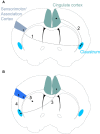The claustrum in review
- PMID: 24772070
- PMCID: PMC3983483
- DOI: 10.3389/fnsys.2014.00048
The claustrum in review
Abstract
The claustrum is among the most enigmatic of all prominent mammalian brain structures. Since the 19th century, a wealth of data has amassed on this forebrain nucleus. However, much of this data is disparate and contentious; conflicting views regarding the claustrum's structural definitions and possible functions abound. This review synthesizes historical and recent claustrum studies with the purpose of formulating an acceptable description of its structural properties. Integrating extant anatomical and functional literature with theorized functions of the claustrum, new visions of how this structure may be contributing to cognition and action are discussed.
Keywords: attention; cerebral cortex; claustrum; connections; function.
Figures



References
-
- Ariëns Kappers C. U., Huber G. C., Crosby E. C. (1936, 1960). The Comparative Anatomy of the Nervous System of Vertebrates, Including Man. New York: Hafner Publishing Company
Publication types
Grants and funding
LinkOut - more resources
Full Text Sources
Other Literature Sources

